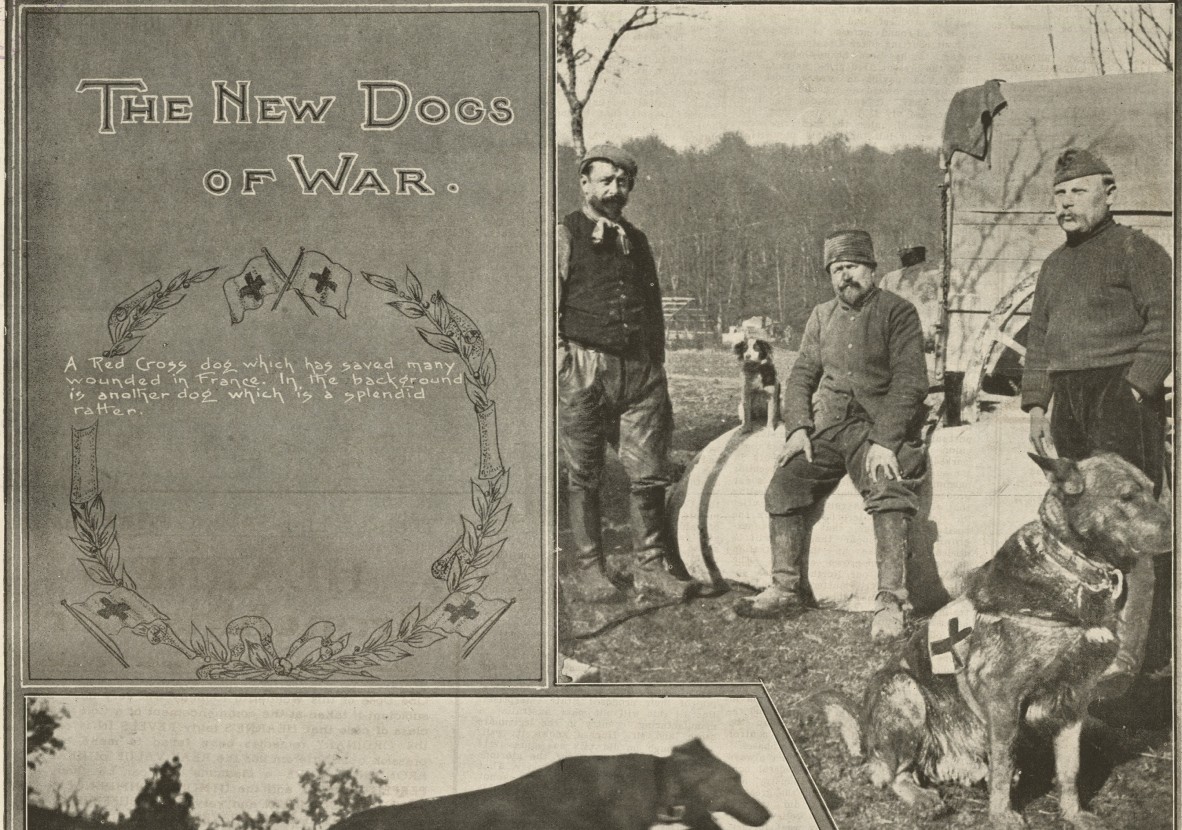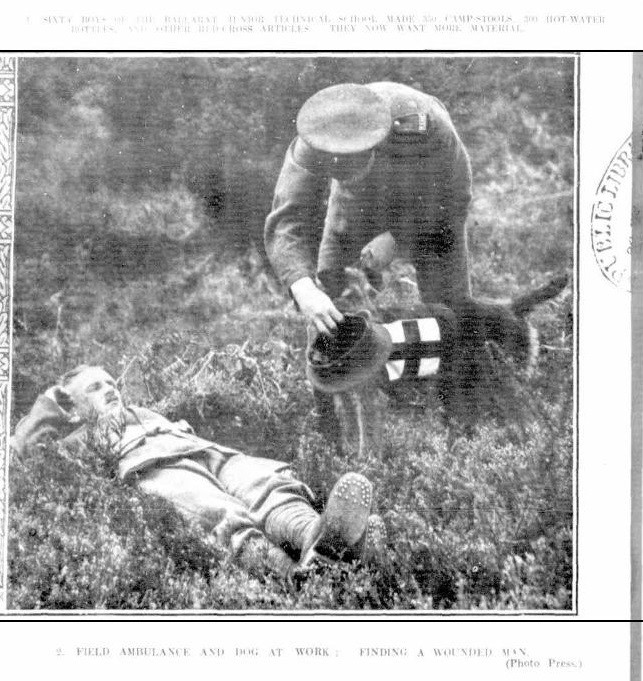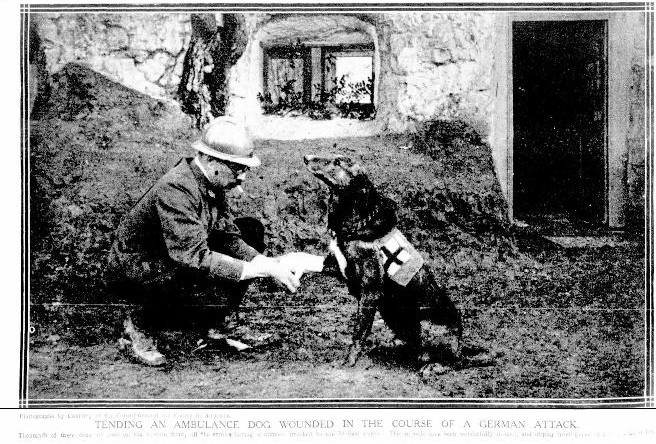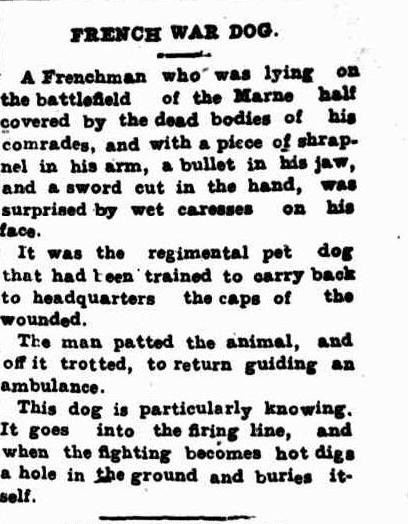Doing Their Bit: Mercy Dogs of WWI
By Alice Rawkins, Visitor Services Assistant, Anzac Square Memorial Galleries | 28 March 2023
The world would be a nicer place if everyone had the ability to love as unconditionally as a dog
Dogs have a long history of military service during times of conflict, trained to complete a variety of tasks depending on their size, breed and intelligence. Just like their owners, dogs were also expected to do their bit for the war effort during the First World War. Recent research reveals that up to 20,000 dogs were trained for frontline positions in this conflict. Many of these animals had been family pets, while others were selected from dog shelters or came from the police forces. They were used to haul machine guns and supply carts, deliver messages, control pests in the trenches, sniff out enemy troops and alert soldiers to danger. Some were also trained to find wounded soldiers in no man's land. These animals became known as mercy dogs.

The Red Cross dog which has saved many wounded in France, 10 March, 1917, Page 21 of the Queenslander Pictorial, supplement to The Queenslander, State Library of Queensland.
Mercy dogs, also sometimes referred to as casualty dogs or ambulance dogs, were first used by German forces in the 19th Century to help locate wounded soldiers on the battlefield and to comfort the dying. By 1908, Italy, Austria, France, and Germany all had programs training mercy dogs. Their popularity continued to grow during WWI, and they were used by most European armies, including British Allied Forces. They tended to be trained by national Red Cross Societies to serve the country in which the specific society operated. The sophistication of their training was astounding. They were taught to ignore dead bodies and enemy soldiers and could understand a huge range of hand signals. In addition to this, each dog was trained to freeze or bury itself if it encountered hostile fire. German Shepherds and Boxers were commonly used as mercy dogs owing to their intelligence and enduring loyalty.

Field Ambulance and dog at work: Finding a Wounded man, Saturday 31 July 1915, page. 32, Australasian, National Library of Australia.
Following large battles, mercy dogs were sent out to assist the wounded. Their heightened sense of smell meant that they were perfect for sniffing out wounded soldiers in thickets, bushes, ditches and mud who otherwise might have been missed. They wore a vest with the Red Cross symbol and carried a saddle bag with first aid supplies, water and liquor that could be used by injured soldiers. Those who could walk would then be led back to the safety of their trenches by the dog. There are also many stories of mercy dogs dragging soldiers back to safety or out of the way of enemy fire. These animals were also trained to guide combat medics to soldiers who required more extensive medical care. The dogs would return to their handlers carrying a cap, glove, or torn scrap of clothing as evidence that they had located a wounded soldier before leading a stretcher party straight back to the victim.

Tending an Ambulance Dog wounded in the Course of a German Attack, Wednesday 15 March 1916, page. 22, Sydney Mail, National Library of Australia.
An article published in the Evening Telegraph on 6 October 1914 described the amazing talent that mercy dogs had for discovering the wounded. In this instance, a French soldier was laying on the battlefield, covered by dead bodies and suffering from multiple wounds when he felt comforting "wet caresses on his face.” It was the regiment's mercy dog, who after receiving a pat from the wounded soldier, trotted off only “to return guiding an ambulance.” Without this dog, the soldier may not have survived his injuries. Several other dogs were recognised for their extraordinary actions during WWI, including a French dog named Captain who located 30 wounded men in a single day, and another named Prusco who was credited with finding a hundred men during one single battle. According to a newspaper article in the Daily Mail, Prusco located soldiers who “had fallen into brushes and depressions from which they were unable to crawl. One after another he dragged them to shelter" (23 June 1917, pg. 9). Prusco’s courage that day highlights why dogs are often referred to as man's best friend.

French War Dog, Tuesday 6 October 1914, page. 5, Evening Telegraph, National Library of Australia.
Beyond providing medical assistance, mercy dogs were also trained to remain with mortally wounded soldiers, offering them comfort and ensuring that they were not alone when they passed. The steady and warm presence of these amazing animals would surely have eased the fear and pain of countless soldiers whose final breaths were taken in no man's land.
As many as 10,000 dogs are known to have served as mercy dogs during WWI, and they are credited with saving thousands of lives, including at least 2,000 in France and 4,000 wounded German soldiers. These dogs became national heroes, highlighting that everyone could do their bit to support the war effort, even our furry friends. Mercy dogs served their nations with commitment, loyalty, bravery, and valor in a way that only dogs could, with many killed while working to save the wounded.
If you are interested in the use of animals during times of war, why not plan a visit to Anzac Square Memorial Galleries? Learn more here: https://www.anzacsquare.qld.gov.au/visit
Comments
Your email address will not be published.
We welcome relevant, respectful comments.